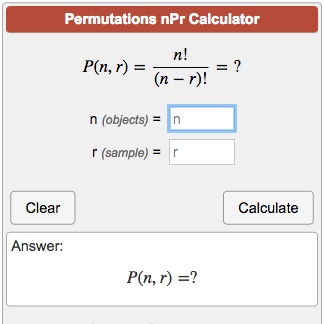

How many ways can a teacher select a group of 3 students to sit in the front row if the class has 13 students? How many ways can a teacher select a group of 6 students to sit in the front row if the class has 13 students? How many different ways can you organize ten teams for each age group? Is this a permutation or combination? The six boys will be led up the hill by a two-seater lift. If the spinner is spun 540 times throughout the day, about how
25 PERMUTE 3 FREE
if a customer spins the spinner and it lands on cat, they will win a free cat toy. the spinner shows the type of toy a customer can win for their pet. How many 4-tones chords (chord = at the same time sounding different tones) is possible to play within 7 tones?Ī pet store is having a prize give-away. What is the probability that it gets a) all four aces b) at least one ace How many different triads can be selected from group 38 students?

How many ways can three books choose to be read?Ĭalculate: (486 choose 159) - (486 choose 327) Marenka is required to read three books out of five designated books. How many options do we have?įoundation of combinatorics in word problems k is logically greater than n (otherwise, we would get ordinary combinations).Ĭ k ′ ( n ) = ( k n + k − 1 ) = k ! ( n − 1 ) ! ( n + k − 1 ) ! Įxplanation of the formula - the number of combinations with repetition is equal to the number of locations of n − 1 separators on n-1 + k places.Ī typical example is: we go to the store to buy 6 chocolates. Here we select k element groups from n elements, regardless of the order, and the elements can be repeated. Their number is a combination number and is calculated as follows:Ĭ k ( n ) = ( k n ) = k ! ( n − k ) ! n ! Ī typical example of combinations is that we have 15 students and we have to choose three. In mathematics, disordered groups are called sets and subsets. The elements are not repeated, and it does not matter the order of the group's elements. k m ! n ! Ī typical example is to find out how many seven-digit numbers formed from the numbers 2,2,2, 6,6,6,6.Ī combination of a k-th class of n elements is an unordered k-element group formed from a set of n elements. Repeating some (or all in a group) reduces the number of such repeating permutations. n = n kĪ repeating permutation is an arranged k-element group of n-elements, with some elements repeating in a group. We calculate their number according to the combinatorial rule of the product: A typical example is the formation of numbers from the numbers 2,3,4,5, and finding their number. 1 = n !Ī typical example is: We have 4 books, and in how many ways can we arrange them side by side on a shelf?Ī variation of the k-th class of n elements is an ordered k-element group formed of a set of n elements, wherein the elements can be repeated and depends on their order. The elements are not repeated and depend on the order of the elements in the group. It is thus any n-element ordered group formed of n-elements. The permutation is a synonymous name for a variation of the nth class of n-elements. For calculations, it is fully sufficient to use the procedure resulting from the combinatorial rule of product. The notation with the factorial is only clearer and equivalent. N! we call the factorial of the number n, which is the product of the first n natural numbers. For example, if we have the set n = 5 numbers 1,2,3,4,5, and we have to make third-class variations, their V 3 (5) = 5 * 4 * 3 = 60. The number of variations can be easily calculated using the combinatorial rule of product. The elements are not repeated and depend on the order of the group's elements (therefore arranged). C k ( n ) = ( k n ) = k ! ( n − k ) ! n ! n = 1 1 k = 3 C 3 ( 1 1 ) = ( 3 1 1 ) = 3 ! ( 1 1 − 3 ) ! 1 1 ! = 3 ⋅ 2 ⋅ 1 1 1 ⋅ 1 0 ⋅ 9 = 1 6 5 The number of combinations: 165Ī bit of theory - the foundation of combinatorics VariationsĪ variation of the k-th class of n elements is an ordered k-element group formed from a set of n elements.


 0 kommentar(er)
0 kommentar(er)
